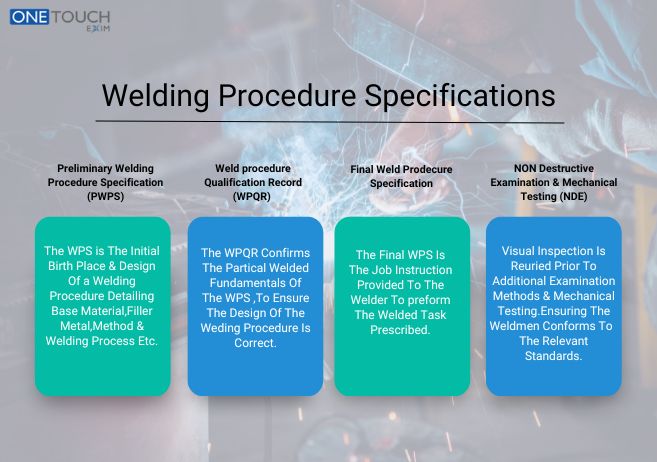Innovative Approaches to Fillet Weld Assessment and Screening: Enhancing Weld Top Quality and Conformity Requirements
In the world of welding, the quality and honesty of fillet welds play an essential duty in making sure the structural sturdiness and dependability of various commercial components. With the consistent drive for improved performance and compliance with stringent criteria, the exploration of cutting-edge methods to fillet weld inspection and screening has ended up being important.
Advanced Non-Destructive Screening Approaches
Making use of cutting edge technologies, progressed non-destructive testing techniques play an essential duty in guaranteeing the integrity and quality of fillet welds. These methods, such as phased array ultrasonic screening (PAUT) and magnetic bit screening (MPT), offer thorough understandings into the weld's interior framework without causing any type of damages to the product. PAUT, as an example, uses numerous ultrasonic components to check the weld from numerous angles, giving a thorough visualization of potential problems like absence of blend or splits.
By employing these advanced non-destructive screening strategies, weld examiners can precisely evaluate the quality of fillet welds, guaranteeing compliance with sector criteria and policies. The ability to detect flaws early on not just improves weld quality yet likewise avoids costly rework or failings in structural stability, underlining the significance of these cutting-edge screening approaches in welding inspections.
Robotics and Automation in Inspection
The assimilation of robotics and automation has changed the examination procedure for fillet welds, enhancing effectiveness and accuracy in high quality assessment. Robotics supply exact control and repeatability in inspecting welds, making certain trustworthy and constant results. Automated systems can be set to comply with details assessment courses, guaranteeing comprehensive protection of welds and reducing the danger of human error.
Robotic examination systems equipped with sophisticated sensing units can spot and determine weld attributes with high accuracy, providing in-depth information for analysis. These systems can determine issues such as cracks, lack of blend, and porosity, enabling prompt rehabilitative activities to be taken. Additionally, robotics and automation enable for real-time data collection and evaluation, supplying immediate comments to operators and assisting in quick decision-making processes.
Moreover, using robotics and automation in fillet weld evaluation improves total performance by decreasing assessment times and raising assessment throughput. By simplifying the evaluation procedure, manufacturers can ensure weld quality and compliance requirements are satisfied effectively, eventually bring about cost savings and improved item high quality.
Using Expert System for Analysis
Fabricated intelligence plays a critical function in enhancing the efficiency and accuracy of analysis in fillet weld examination procedures. By using the power of AI, assessors can simplify the analysis of weld high quality and compliance requirements, resulting in much more reputable and accurate results. AI formulas can quickly process vast quantities of information from weld assessments, discovering problems or inconsistencies that might be testing to understand the naked eye. This sophisticated innovation enables real-time surveillance of weld high quality, enabling for immediate rehabilitative actions to be taken if any kind of problems are discovered.
Furthermore, AI systems can gain from past examination data, constantly boosting their ability to identify prospective issues and discrepancies in fillet welds. This adaptive understanding capability enhances the general quality assurance procedure, reducing the possibility of human mistake and making certain that welds meet the required standards. By incorporating expert system into fillet weld analysis, markets can accomplish greater degrees of efficiency, consistency, and compliance in their inspection methods.
Portable Devices for On-Site Inspection
 Enhancing area assessment effectiveness, the adoption of mobile tools transforms on-site assessment processes for fillet welds. These tools offer adaptability and convenience, allowing examiners to carry out extensive assessments in various locations, including challenging or remote atmospheres. Portable tools such as ultrasonic testing gadgets, magnetic bit assessment devices, and digital radiography systems offer real-time data and high-resolution imaging abilities, allowing quick decision-making and immediate feedback on weld top quality.
Enhancing area assessment effectiveness, the adoption of mobile tools transforms on-site assessment processes for fillet welds. These tools offer adaptability and convenience, allowing examiners to carry out extensive assessments in various locations, including challenging or remote atmospheres. Portable tools such as ultrasonic testing gadgets, magnetic bit assessment devices, and digital radiography systems offer real-time data and high-resolution imaging abilities, allowing quick decision-making and immediate feedback on weld top quality.One substantial benefit of portable devices is their capacity to streamline inspection treatments, reducing downtime and improving general performance. Assessors can easily carry these devices to various work sites, eliminating the need for carrying heavy machinery or parts to off-site facilities. Furthermore, the mobility of these devices promotes cost-effectiveness by lessening transportation expenses and increasing assessment timelines.
Additionally, using mobile tools for on-site assessment promotes aggressive quality assurance steps, as assessors can immediately identify and resolve any type of potential welding issues or inconsistencies. By incorporating these ingenious technologies right into on-site evaluation techniques, welding professionals can make certain conformity with industry requirements and enhance weld high quality, inevitably resulting in boosted structural honesty and safety in different welding applications.
Integration of Data Management Solution
Having enhanced on-site examination processes with the application of portable tools, the following stage involves the smooth click resources assimilation of data monitoring systems to even more improve performance and data analysis abilities in fillet weld examination and testing. Welding Inspection Racine. By integrating data administration systems right into the inspection process, companies can simplify information collection, storage, and analysis. This combination permits real-time surveillance of weld top quality, immediate identification of problems, and timely decision-making to remedy any kind of issues that may occur during the assessment process
Information monitoring systems play an essential function in systematizing examination information, facilitating very easy access for authorized personnel, and ensuring data integrity and safety and security. Through the integration of these systems, inspectors can generate comprehensive records, track historic information for fad evaluation, and boost general process effectiveness. The assimilation of information administration systems enables smooth interaction between different stakeholders involved in the assessment procedure, fostering collaboration and enhancing general top quality control measures. Inevitably, the assimilation of data administration systems offers to raise the standards of fillet weld examination and screening, guaranteeing conformity with market regulations and improving weld quality.
Conclusion
In final thought, innovative strategies to fillet weld inspection and testing have actually significantly improved weld top quality and conformity standards. Advanced non-destructive testing techniques, robotics, automation, artificial intelligence, portable devices, and data management systems have actually changed the method weld examinations are conducted. By utilizing these innovations, markets can make certain that welds fulfill the required quality requirements and guidelines, inevitably boosting overall efficiency and safety and security in welding processes.

By using these innovative non-destructive screening strategies, weld assessors can properly analyze the top quality of fillet welds, ensuring compliance with industry criteria and laws. Portable browse around here tools such as ultrasonic screening tools, magnetic fragment assessment devices, and digital radiography systems offer real-time data and high-resolution imaging abilities, enabling fast decision-making and prompt comments on weld high quality.
Having actually enhanced on-site evaluation processes via the application of portable tools, the following stage involves the smooth assimilation of data management systems to further boost effectiveness and information analysis capabilities in fillet weld examination Find Out More and testing (Welding Inspection Racine). Ultimately, the assimilation of data management systems serves to raise the standards of fillet weld inspection and screening, guaranteeing conformity with market regulations and boosting weld high quality
 In final thought, ingenious techniques to fillet weld assessment and testing have actually substantially enhanced weld top quality and compliance standards.
In final thought, ingenious techniques to fillet weld assessment and testing have actually substantially enhanced weld top quality and compliance standards.